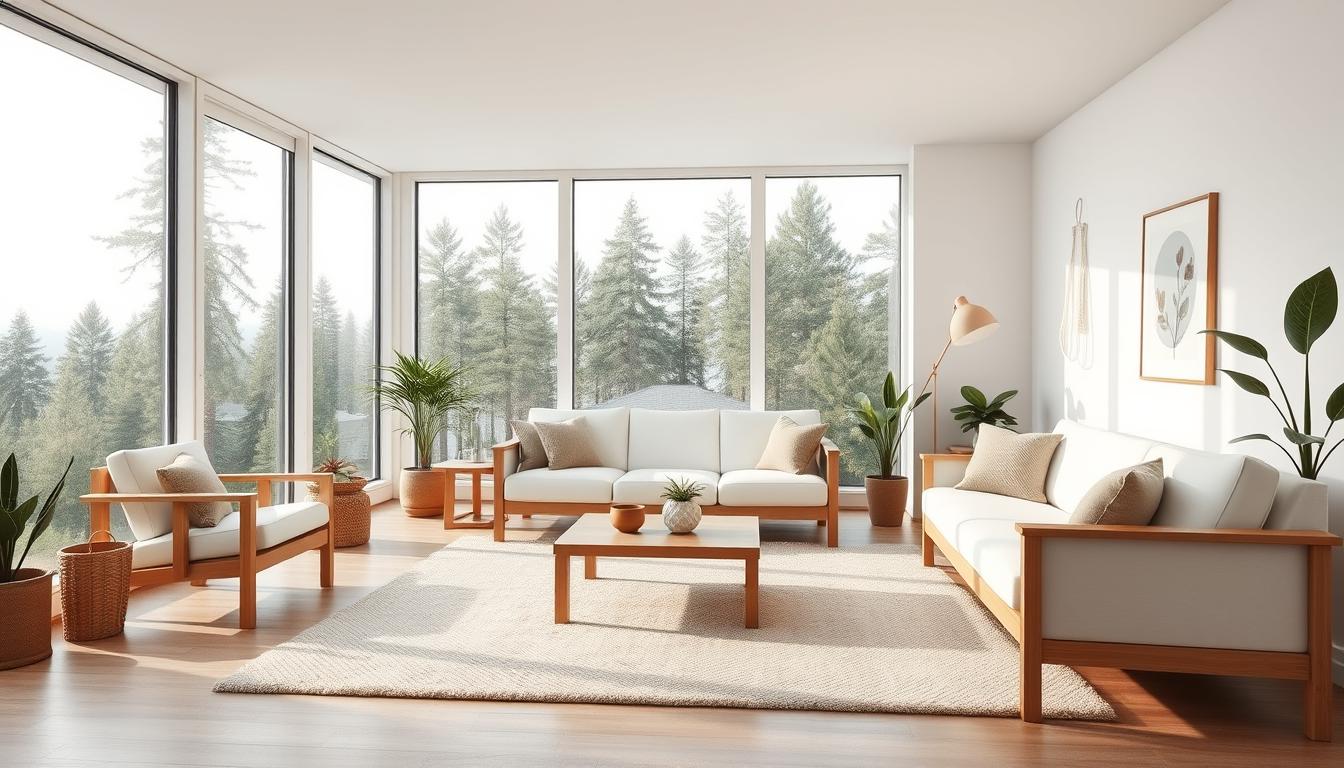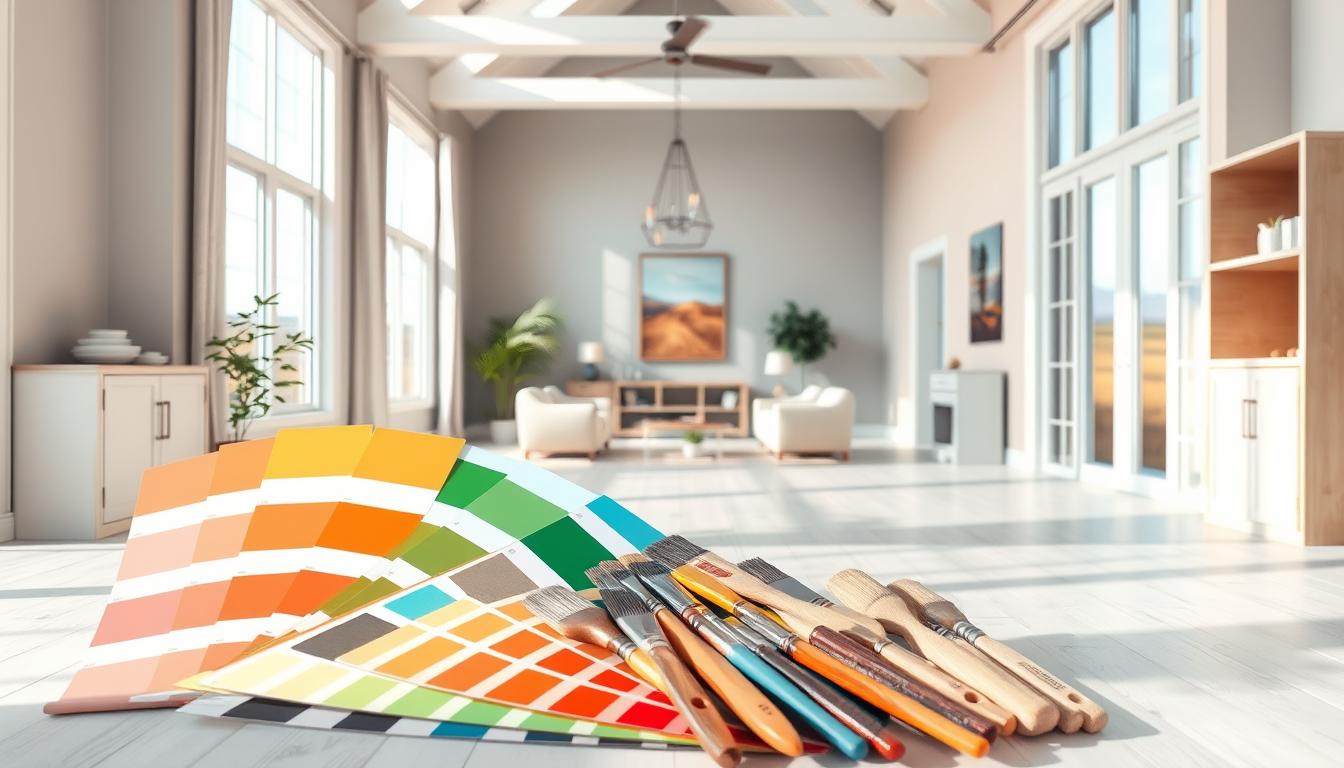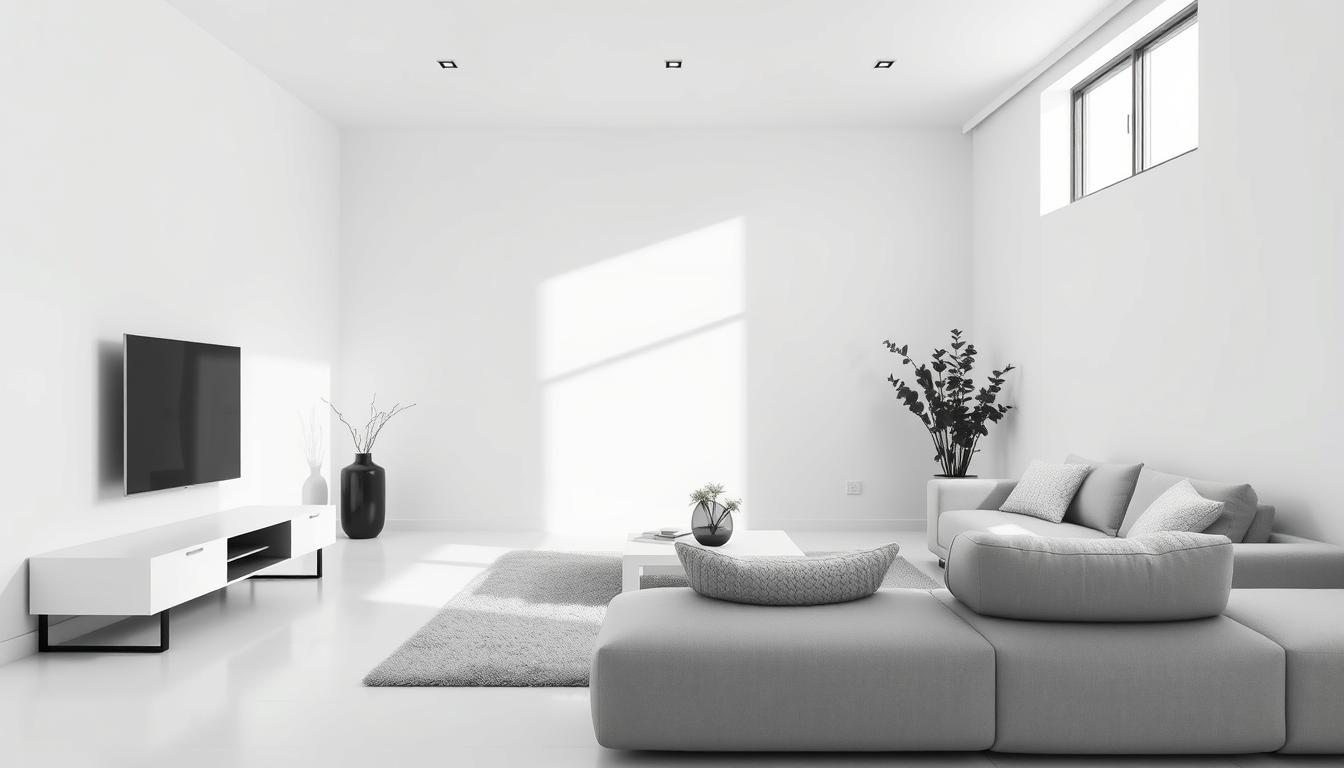Did you know Scandinavian countries are often seen as the happiest? Their interior design might play a big role. It focuses on coziness, function, and simplicity.
We’ll dive into what makes Scandinavian design special. You’ll learn about its key traits, color schemes, and must-have furniture. This knowledge will help you create a calm, Scandinavian vibe in your home.
Our journey through Scandinavian design will offer useful tips for your home. Whether you want to update one room or redo your whole space, we’ve got you covered.
Key Takeaways
- Understanding the core principles of Scandinavian design
- Learning how to choose a fitting color palette
- Discovering essential furniture pieces for a Scandinavian look
- Implementing practical tips for a serene living space
- Creating a cozy atmosphere with minimalistic elements
Introduction to Scandinavian Home Interior Design
Scandinavian home interior design focuses on simplicity and functionality. It’s known for creating cozy, inviting spaces that look great and work well.
What Defines Scandinavian Design?
Scandinavian design loves clean lines and minimal decoration. It also connects deeply with nature. This style aims to bring hygge (coziness) and warmth into your home. Natural materials like wood, leather, and textiles are key.
If you want a minimalist Scandinavian style home, keep it simple and functional. Say no to clutter and too much decoration. Go for a clean, uncluttered look instead.
The Importance of Minimalism
Minimalism is at the heart of Scandinavian design. It makes spaces calm and serene. This design encourages living mindfully, valuing quality over quantity.
“The art of creating a beautiful and functional space lies in the ability to balance form and function, a principle that is at the heart of Scandinavian design.” Explore more interior design styles to find the one that suits your taste.
Natural Elements and Materials
Scandinavian design loves natural elements and materials. Wood is a big part of it, with many homes having wooden floors, furniture, and accents. Stone, wool, and linen add warmth and texture too.
Following these principles can make your home Scandinavian-inspired. It can be both beautiful and functional. Whether you prefer the minimalist Scandinavian style or the cozy warmth of hygge, Scandinavian design is timeless.
Key Characteristics of Scandinavian Interiors
Scandinavian interiors have several key elements that make them special. They focus on creating a space that is both beautiful and functional. This means a home that is comfortable and easy to use.
Light and Airy Spaces
Scandinavian homes are known for being light and airy. This is done by using light colors on walls and floors. These colors reflect light, making rooms feel bigger. It’s also important to keep things tidy to let light move freely.
Here are some nordic home design tips to achieve this:
- Choose a white or light-colored palette for walls and floors.
- Go for sheer curtains or blinds to let in natural light.
- Keep surfaces clear to keep the space open.
Functional and Practical Layouts
Scandinavian design values functionality. Homes are laid out to be practical, with furniture that has a purpose. This makes the space easy to use and clutter-free.
For a functional layout, consider these tips:
- Choose furniture that can be used in more than one way.
- Design a layout that makes it easy to move around.
- Use stylish storage solutions that are also practical.
Emphasis on Coziness
Scandinavian homes are cozy, despite their minimalist look. This coziness comes from textiles and warm lighting. Soft materials and warm light add a welcoming feel to a room.
To make your home cozier, try these ideas:
- Add layers of textiles like wool blankets and linen pillows.
- Use warm lighting to create a cozy feel in the evenings.
- Bring in natural elements like wood and plants for warmth.
Color Palettes in Scandinavian Design
In Scandinavian design, choosing colors is key to a peaceful home. The colors used are not just pretty; they also make the home feel cozy and warm.
Neutral Tones and Earthy Hues
Scandinavian homes often use neutral and earthy colors. Shades like white, beige, gray, and brown create a calm background. They also make rooms look bigger and brighter.
The earthy tones are inspired by Scandinavia’s nature. This brings the outdoors into the home. It helps create a peaceful and healthy living space.
Pops of Color and Accent Walls
Even though neutral colors are common, Scandinavian homes sometimes add pops of color. This can be through accent walls, decorations, or furniture. The goal is to use color in a way that keeps the space calm and simple.
| Color Element | Description | Effect |
|---|---|---|
| Neutral Tones | Shades of white, beige, gray | Creates a calm and serene atmosphere |
| Earthy Hues | Browns, taupes, greens | Bring warmth and a connection to nature |
| Pops of Color | Bold colors used sparingly | Adds visual interest and personality |
Scandinavian design balances neutral colors with bold accents. This creates a beautiful and welcoming look. It’s not just about looks; it also makes the home feel good.
Furniture Essentials for Scandinavian Spaces
Scandinavian furniture design is all about simplicity, comfort, and being practical. When you’re setting up a Scandinavian-inspired home, picking furniture is key. It should look good and be useful.
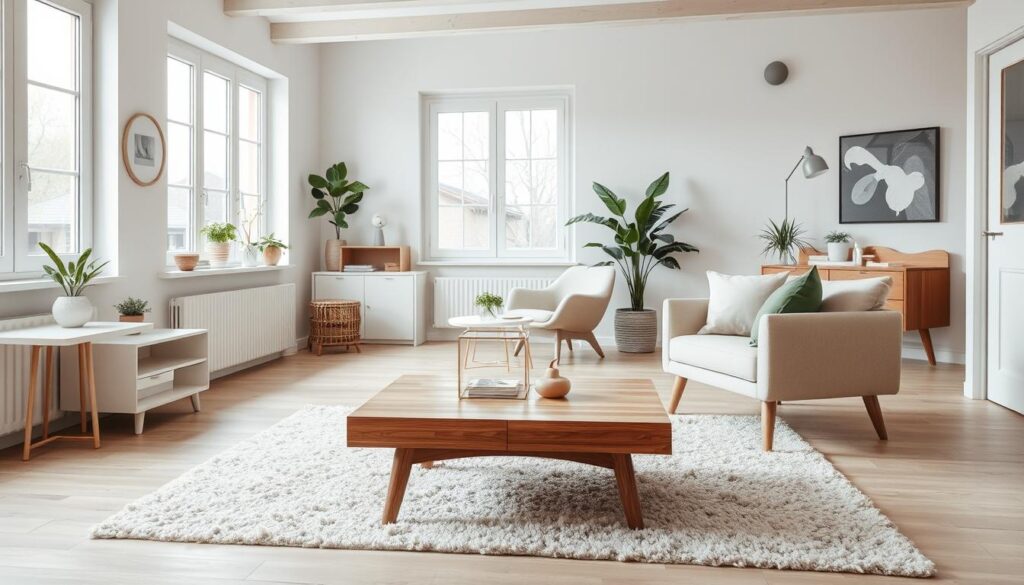
Iconic Scandinavian Furniture Brands
Scandinavian countries are famous for their top-notch furniture brands. IKEA and Muuto are leaders in Scandinavian design. They offer stylish, functional pieces that stand out.
These brands are known for their creative use of materials and love for minimalism.
Some iconic pieces from these brands include:
- The IKEA POÄNG chair, known for its comfort and versatility.
- Muuto’s COVER lounge chair, which combines style with functionality.
Choosing Multi-functional Pieces
In Scandinavian design, multi-functionality is key. Furniture that does more than one thing is highly valued, perfect for small homes. For example, a storage ottoman can be a seat and a storage unit. A murphy bed can fold up against the wall when not in use.
| Furniture Piece | Functionality | Benefits |
|---|---|---|
| Storage Ottoman | Seat and Storage | Saves space, provides additional seating |
| Murphy Bed | Bed and Wall Space | Maximizes floor space, versatile |
| Nesting Tables | Multiple Table Surfaces | Flexible, saves space when not in use |
As
“Good design is about more than just aesthetics; it’s about creating a functional and comfortable living space.”
, a principle that is deeply ingrained in Scandinavian design philosophy.
By focusing on simplicity, functionality, and comfort, and by choosing multi-functional furniture pieces, you can create a Scandinavian-inspired home that is both beautiful and practical.
Textiles and Accessories
In Scandinavian design, textiles are key to adding warmth and coziness. They make a space look good and feel inviting. This is what makes scandi-inspired interiors so special.
The Role of Textiles
Textiles are essential in Scandinavian home decor. They help make a room cozy and welcoming. You’ll find throw blankets and rugs, all made from natural materials like wool, linen, and cotton.
Scandinavian design loves mixing textures and patterns. This makes a room more interesting to look at. For example, a woolen throw can go well with a linen sofa, creating a cozy and balanced look.
Layering for Comfort and Warmth
Layering textiles is a big part of Scandinavian design. It helps make a room both comfortable and warm. By using throws, pillows, and rugs together, you can make a space look good and feel cozy.
To layer textiles well, start with a rug. Then add throws and pillows that match in texture and pattern. This not only adds warmth but also makes the space more interesting to look at.
| Textile Type | Common Uses | Benefits |
|---|---|---|
| Wool | Throws, blankets, rugs | Warmth, durability |
| Linen | Upholstery, curtains | Natural look, breathability |
| Cotton | Pillows, bedding | Softness, versatility |
Using different textiles and layering them right can make your home look cozy and stylish. It’s all about creating a scandi-inspired interior that feels welcoming and looks great.
Lighting in Scandinavian Interiors
Scandinavian design focuses on finding the right light balance. It’s not just about seeing; it’s about feeling warm and cozy. Lighting is key to creating a welcoming space.
Natural Light: The Scandinavian Approach
Scandinavians love natural light, which is rare in winter. They make the most of it in their homes. This is done through:
- Large windows for more sunlight
- Minimal window treatments for clear light
- Mirrors to reflect light and make rooms look bigger
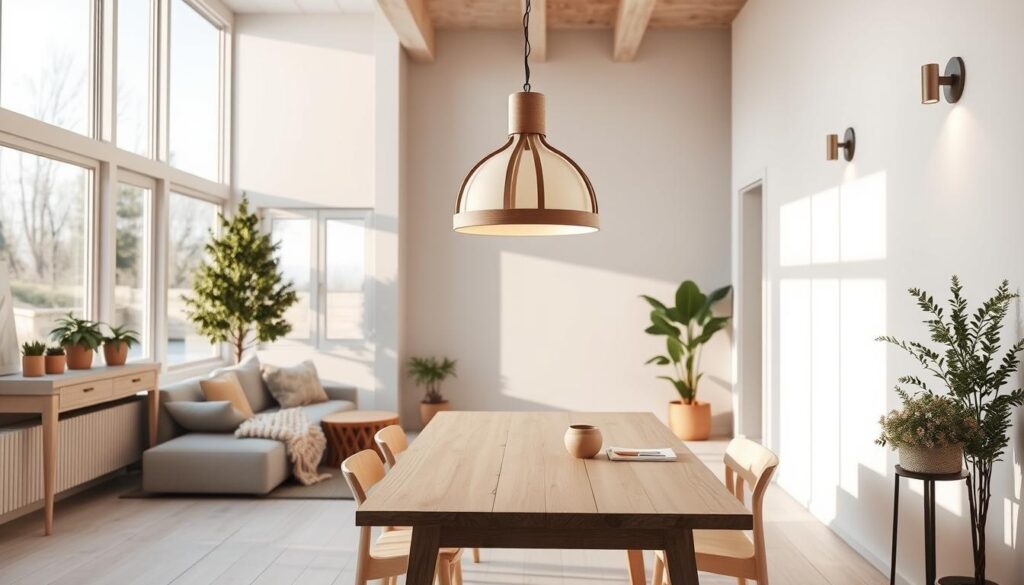
Modern Lighting Fixtures
When natural light is scarce, modern lights are essential. Scandinavian design favors simple, functional lighting. It often includes:
- Unobtrusive designs that fit in
- Energy-saving options for the planet
- Layered lighting for a cozy feel
Popular choices are pendant lights, table lamps, and floor lamps. They’re known for their clean lines and simplicity. Designers like Arne Jacobsen and Poul Henningsen are famous for their modern Scandinavian style.
By mixing natural light with modern fixtures, Scandinavian homes get a perfect balance. They’re both useful and beautiful.
Incorporating Nature into Your Home
Scandinavian design loves to bring the outdoors inside. This makes our homes feel more welcoming and cozy. Adding elements of nature can do just that.
Biophilic Design Principles
Biophilic design connects us with nature. It uses natural elements like plants, wood, and stone in our homes.
Some key biophilic design principles include:
- Maximizing natural light
- Using natural materials and textures
- Incorporating plants and greenery
- Creating views of nature
Indoor Plants and Greenery
Indoor plants are more than just decorations. They help clean the air and make us feel better.
Some easy-to-care-for plants for indoors are:
- Snake Plant, known for its air-purifying properties
- Pothos, easy to care for and versatile
- ZZ Plant, requiring minimal maintenance
Adding these plants to our homes boosts the hygge feeling. It makes our space feel more natural and inviting.
Creating a Cozy Atmosphere
Scandinavian design is all about making spaces warm and inviting. It uses lighting, textiles, and colors to create a cozy feel. This makes your home feel comfortable and welcoming.
The Concept of “Hygge”
“Hygge” is a Danish word that means coziness, warmth, and comfort. It’s about making a space that feels snug and welcoming. In Scandinavian homes, “hygge” is created with soft lights, plush fabrics, and warm colors.
To bring “hygge” into your home, use candles, soft blankets, and warm wood furniture. These elements add warmth and make your home feel inviting.
Utilizing Warmth and Comfort
Creating warmth and comfort in your home is more than just looks. It’s about making a sensory experience. Use different textures like wool, linen, and velvet to add depth and interest.
Warm lighting also makes a space cozy. Try using table or floor lamps with warm shades. They create soft light that makes you want to relax.
By following “hygge” and adding warmth and comfort, you can make your home cozy. It will show off the beauty of Scandinavian design.
Tips for Implementing Scandinavian Design in Your Home
Adding minimalist Scandinavian style to your home is easy. Just focus on key areas and mix form and function. This way, you’ll get a space that looks great and works well.
Key Areas to Focus On
Begin by adding Scandinavian touches to your living room and kitchen. Use natural materials, neutral colors, and practical furniture. IKEA and Muuto have stylish, affordable items to help you start.
Balancing Form and Function
For a true Scandinavian look, balance form and function. Pick furniture that’s useful yet simple. This makes your space both beautiful and useful.
By following these tips, you can bring Scandinavian design into your home. Enjoy a calm, tidy living space.

